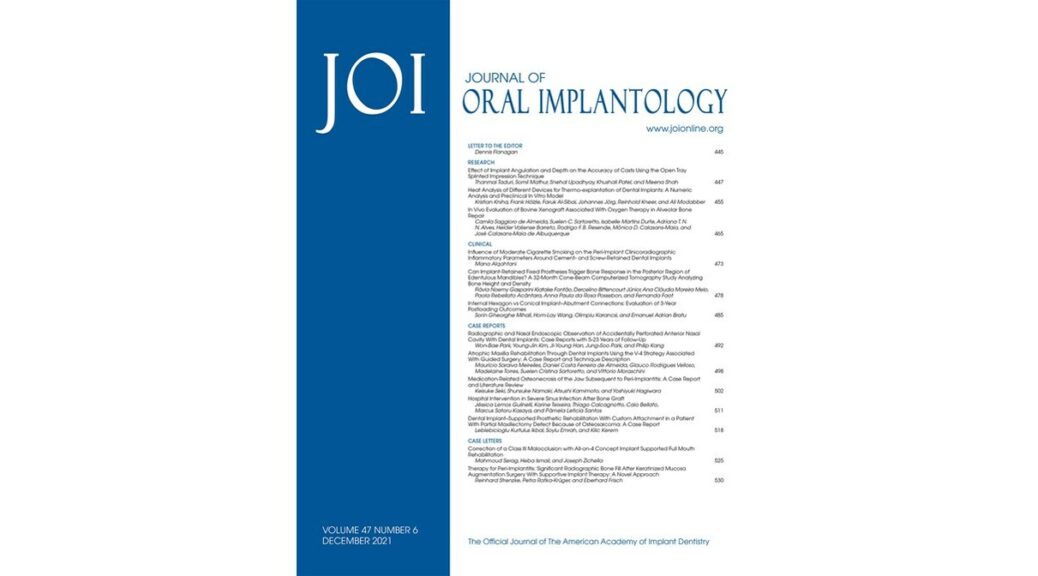In this retrospective triple case report, published in the Journal of Oral Implantology, researchers aimed to present and discuss the technical considerations related to using a new maxillary sinus surgical guide to improve surgical outcomes.
LAWRENCE, KS, Sept. 21, 2023 /PRNewswire-PRWeb/ — Journal of Oral Implantology – Dental implant procedures can be challenging no matter the placement location in the mouth; however, implants in the back of the mouth—premolar and molars—can be especially difficult. The complication occurs when the original tooth is extracted, which can expand or pneumatize the sinus cavity. Dental Implant surgeons frequently use a sinus floor elevation via lateral window (LSFE) procedure to help counteract this effect. While the LSFE is a predictable, commonly used technique, it can lead to adverse effects, including sinus membrane perforation and significant bleeding. Safer molar extraction and implantation techniques are necessary to decrease these adverse effects. The Journal of Oral Implantology recently published a retrospective triple case report by collaborating researchers from the Pontifical University Catholic of Rio Grande do Sul, Porto Alegre, Brazil; the University of Michigan School of Dentistry, Ann Arbor, MI; the Shahid. Beheshti University of Medical Sciences, Tehran, Iran; and the Virginia Commonwealth University, Richmond, VA. Lead author Priscila C. Meneghetti, DDS, MS, and colleagues state, “To promote accurate surgical procedures and improve the surgical workflow with simultaneous implant placement, a 3D printed surgical guide was designed to incorporate the lower contour of the maxillary sinus access window and the ideal 3D position of the implant. This article aims to present and discuss technical considerations related to using this new maxillary sinus surgical guide to improve surgical outcomes.”
Meneghetti et al. conducted a retrospective three-case report on patients qualified for the LSFE technique with a simultaneous implantation procedure using the “all-in-one LSFE and implant placement surgical guide” designed by an experienced digital dental clinical. All patients underwent dental implant surgery to replace the first molar in conjunction with LSFE done under intravenous sedation. The implant achieved primary stability in all cases, and the procedures were done without complication.
Postoperative follow-up occurred at two, four, eight weeks, and five months. No severe adverse effects, including unmanageable pain, swelling, nausea, or nosebleeds, were reported in any of the three patients. All implants were confirmed to be successfully placed and healing as expected. This advanced digital dentistry technique also successfully minimized sinus membrane perforation and excessive bleeding that can occur during the LSFE surgery.
This retrospective triple case report showed that innovative digital dentistry workflow could significantly limit complications stemming from LSFE surgery with subsequent molar implantation. Meneghetti and colleagues state, “The relevant digital workflow was described and supported by documentation of three clinical cases with patients experiencing successful grafting and implant placement procedures. However, further studies must be performed to determine if this technique would be generalizable, as only one operator performed all procedures. Additionally, more investigation could clarify if this method would translate to multiple implant placements and sites lacking posterior teeth.”
Full text of the article, “Digitally Guided Lateral Sinus Floor Elevation With Simultaneous Implant Placement: 3 Case Reports With Technical Considerations,” Journal of
Oral Implantology, Vol. 49, No. 4, 2023, is available at https://doi.org/10.1563/aaid-joi-D-22-00198R2
About Journal of Oral Implantology
The Journal of Oral Implantology is the official publication of the American Academy of
Implant Dentistry. It provides valuable information to general dentists, oral surgeons, prosthodontists, periodontists, scientists, clinicians, laboratory owners and technicians, manufacturers, and educators. The JOI distinguishes itself as the first and oldest journal in the world devoted exclusively to implant dentistry. For more information about the journal or society, please visit: http://www.joionline.org/orimonline/?request=index-html.
Pull Quote
All implants were confirmed to be successfully placed and healing as expected
Media Contact
Samantha Weinkauf, KnowledgeWorks Global Ltd., 1 785-289-2649, Samantha.Weinkauf@kwglobal.com
SOURCE Journal of Oral Implantology


